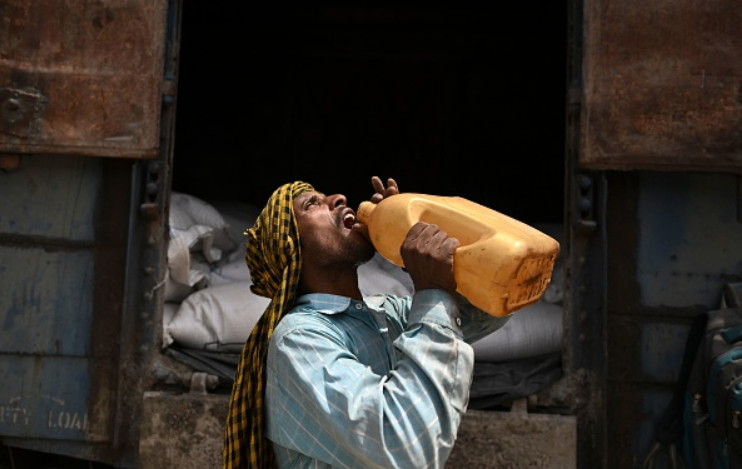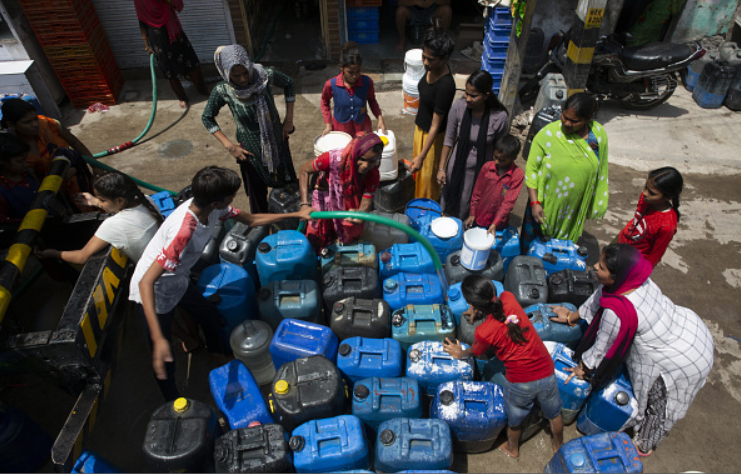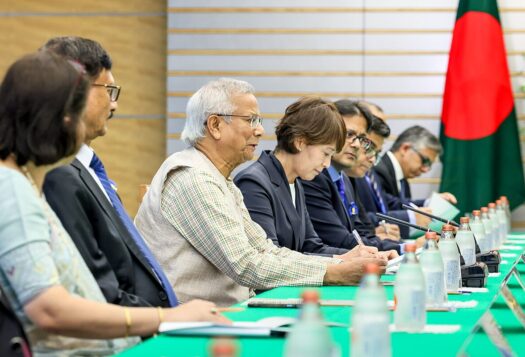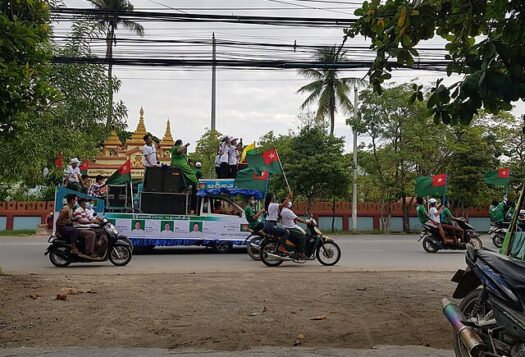
Extreme heat is wreaking havoc across India. During the March-April 2022 heatwaves, the Indian Meteorological Department (IMD) recorded the hottest March on record, with temperatures soaring as high as 47 degrees Celsius (117 degrees Fahrenheit) and impacting 15 states and union territories. Finding themselves confronted with oppressive temperatures, individuals with the means hid out in their AC-powered homes while the less privileged across the nation were forced to swelter away in unlivable heat, leaving them exposed to an array of heat-related illnesses, from dehydration to heat stroke. Estimates suggest that the heatwaves caused farmers in Haryana, Uttar Pradesh, and Punjab, who collectively produce more than 25 percent of the nation’s wheat, could lose 10 to 35 percent of their wheat crop yields, a key staple food across India. Due to crop destruction, wheat prices rose by up to 15 percent in some regions, causing further food insecurity. The extreme temperatures caused chaos across all aspects of society – schools closed early or shortened their hours in nine northern states while surveys found that three in five Indian homes faced power outages during the heatwave. In more ways than one, the 2022 heatwaves proved calamitous for India.
Unfortunately, the March-April 2022 heatwaves were only a preview of what is to come. In recent research, IMD has identified a worrying trend of increasingly frequent heatwaves, with the number of heatwave days increasing by almost 50 percent every 10 years between 1981 and 2020. Further, the combined effect of rising temperatures and growing urbanization driving half the Indian population to cities by 2050 is predicted to intensify “urban heat island effects”—the phenomena of increased temperatures in urban centers due to the replacement of natural land cover with city infrastructure.
Unfortunately, the March-April 2022 heatwaves were only a preview of what is to come. In recent research, IMD has identified a worrying trend of increasingly frequent heatwaves, with the number of heatwave days increasing by almost 50 percent every 10 years between 1981 and 2020.
Due to its catastrophic impacts, extreme heat is gaining traction across Indian national and state-level policy agendas. Yet, despite innovations at the state level many still wonder if the effort is coordinated and comprehensive enough to face the existential threat ahead. Although the Center has provided an instructive framework for action, states have been left to manage and mitigate extreme heat largely independently, with few resources provided by the national seat of power. While some states have been slow to act, others such as Gujarat, Odisha, Telangana, and Andhra Pradesh have led the way with innovative, forward-thinking policies to tackle extreme heat which provide valuable learnings for future policymaking within India and abroad.
Setting the Foundation: the Center’s Guidance
At a national level, extreme heat is undoubtedly a policy priority. India’s extreme heat response is coordinated by two central bodies with the IMD leading heat forecasting and heatwave alert communications, and the National Disaster Management Authority (NDMA) setting national definitions for heatwaves. Using heat mapping—a technique which collates and analyzes temperature data to identify heat hotspots in a geography—the two agencies have identified 23 heatwave-prone states and 130 cities which they have recommended develop Heat Action plans, a document which combines assessments and actions across agencies to respond to and reduce heat-related risks. While the Center published heatwave management guidelines with recommended interventions to reduce extreme heat in 2019, state and city-level heat action planning has remained relatively independent. Given the heterogeneity in conditions across India—not just climatic, but also political, social, economic, and cultural—state-led action, in many ways, is the most practical route to ensuring that extreme heat interventions are tailored to local needs and resources. However, further financial resources and pressure need to be provided from the Center to jumpstart vulnerable states into action planning and implementation.
Pioneering States Leading Action Against Extreme Heat
Gujarat has long been a global leader in extreme heat management, publishing the first government-led Heat Action Plan in 2013. Since then, Ahmedabad has expanded its extreme heat management initiatives with a particular emphasis on the implementation of cool roofs—highly reflective roof surfaces which have been found to lower indoor building temperatures by two to five degrees Celsius as compared with traditional roofs made from corrugated tin, asbestos sheets, or concrete. The initiative was first piloted in 2017 where 3,000 tin roofs in slum communities in Ahmedabad painted with cool paint were found to have lower indoor temperatures. Building off the pilot’s success, the city launched a cool roof program in 2020 which seeks to paint more than 15,000 slum roofs and 1,000 government buildings with cool paint.

In Odisha, the Disaster Management Authority has implemented a comprehensive, technology-first public awareness communications system for extreme heat management. To reach the masses and vulnerable groups who may not have smart phones, electronic screens with heat warnings and heat information have been set up at busy traffic intersections and marketplaces. Further, a website and smartphone app has been created to disseminate heat alerts and enable users to identify resources such as the nearest heat shelter and/or public water station.
Despite only being established as a state in 2014, Telangana has been proactive with its extreme heat management campaigns. Alongside cool roof programs, another central area of focus has been tree reforestation as part of the Harithra Haram program which aims to increase the tree cover in the state from 24 to 33 percent. Amongst other benefits, tree reforestation has been found to reduce peak summer temperatures from one to five degrees Celsius through providing shade and evapotranspiration (the combined process through which water moves directly and indirectly from soil and the roots and bodies of vegetation and water bodies into the air). With an aim to combat urban heat islands, urban forestry has been a key pillar within Harithra Haram, with efforts focused on Hyderabad, the capital city of Telangana. As a result, Hyderabad has increased its forest cover by 147 percent over a 10-year period from 2011 to 2021, the maximum forest cover gain amongst all Indian mega-cities.
In Andhra Pradesh, extreme heat management has been an impressively coordinated effort across state level agencies, local bodies, and NGOs. The program which best exemplifies the success of this effort has been the government’s public water and cooling shelter programs which aim to provide vulnerable communities respite from extreme heat exposure outdoors. According to reports by the Andhra Pradesh Disaster Management Authority, between 2019 and 2020, local government bodies supported by NGOs organized 62,228 Challivendram drinking water camps across 13 districts. Further, the report also estimated that 54,380 cooling shelters were provided across local bodies such as panchayats, government departments, workplaces, and NGOs.
Looking ahead: addressing challenges in India’s extreme heat response
While several states have made notable progress in implementing interventions to reduce the impacts of extreme heat, there are still several operational gaps in India’s approach. First, while national heatwave temperature thresholds have provided guidelines for states, a dearth of data collection at the ground-level has prevented the development of targeted heatwave protocols and interventions at the local level. Additionally, though the NDMA notes that 17 states have heatwave action plans, implementation of the plans has been inconsistent. For example, during the March-April 2022 heatwaves, news coverage in Bihar noted the lack of widespread implementation of the state’s heat action plans, restricting their focus to reactionary policies such as reduced and/or altered work and school hours to avoid peak heatwave periods.
With the socio-economic impacts of extreme heat extending far beyond the domain of a single agency, short and long-term interventions need to be a coordinated effort driven across agencies, from public health to urban development, as opposed to being solely championed by disaster management and environmental agencies.
This is in part due to the fact that extreme heat financing remains challenging as heatwaves are not officially listed as disasters by the NDMA, thus inhibiting states from qualifying for immediate relief assistance from the National Disaster Response Fund (NDRF). Whilst states that are heatwave-prone can use up to ten percent of funds available under their state NDRF allocation if they officially list heatwaves as natural disasters, only seven states appear to have adopted this approach. Overall, resources need to be made available to help states create and implement targeted heat action plans.
Further, extreme heat management needs to be prioritized as a whole-of-government and society initiative. With the socio-economic impacts of extreme heat extending far beyond the domain of a single agency, short and long-term interventions need to be a coordinated effort driven across agencies, from public health to urban development, as opposed to being solely championed by disaster management and environmental agencies. Additionally, partnering with local NGOs and district/panchayat level bodies will be critical to mitigating the injurious impacts of extreme heat by ensuring that interventions are tailored to specific needs and populations, such as informal settlement/slum dwellers, outdoor workers, and the elderly.
With heatwaves plaguing swathes of the world from Asia to Europe this year alone, extreme heat is an ever-growing existential threat. Now more than ever, the sharing of policy lessons from national, state, and local levels, from India as well as other forward-looking countries, will prove valuable in the global fight against the disastrous impacts of climate change.
***
Image 1: SAJJAD HUSSAIN/AFP via Getty Images


